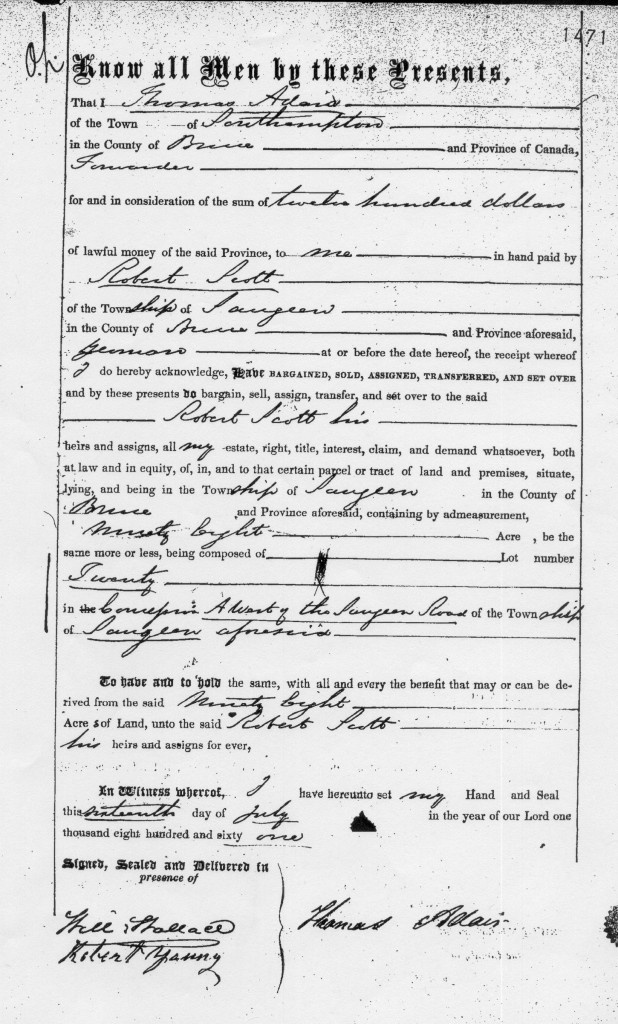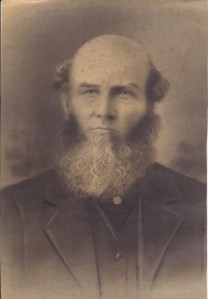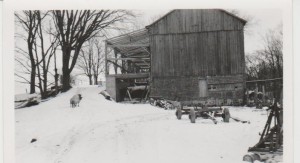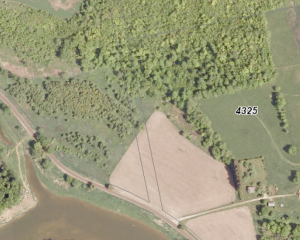The first paper record of this farm was transacted Nov. 8, 1853 (Township Papers # 1469) when Thomas Adair requested permission from Crown Land agent Alex McNabb to “occupy and cultivate with a view of purchasing in conformity to the regulations” both lots 20 and 21 Range West of Saugeen Road (RWSR).

On July 16, 1861, Thomas Adair, then of Southampton, according to the 1861 census, (Township Paper # 1471) sold Lot 20 for $1200 to Robert Scott. There is no record of how much land was cleared or the number or size of any buildings on the lot when Robert Scott received the Crown deed on May 7, 1864, a total of 98 acres.

On Aug. 6, 1864, Robert Scott sold 40 square rods (¼ acre) at NE corner, to James Calder, a merchant from Southampton and a business partner of Thomas Adair at that time. James Calder was also the first storekeeper arriving to open his shop in Saugeen (now Southampton) in the spring of 1851. A later weekly paper, Southampton Morning Star, dated Jan. 23, 1862, reported that “James Calder paid cash for wheat, potatoes and raw furs”. According to the same paper, “he also operated a store at Dunblane, which he wanted to sell.” (John Weichel, Forgotten Lives: Early history of a coastal village (Hanover: The Bruce County Museum & Archives, 2001), 24
Evidently Mr. Calder began the Dunblane store before the sale of lot 20 using the building that Adair may have built to address his settlement duties. A small part of the obituary of Mr. Hugh McLaren, who died suddenly in Hepworth, at age 75 in 1919, explains a little of what may have happened. “Hugh McLaren was born in the city of Perth, Scotland, 75 years ago. At nine years of age he came with his parents to Canada locating at Southampton. Even at nine years business called him and he began working in Calder’s general store, and at ten years of age he managed a branch store for Mr. Calder at Dunblane.”
There is an interesting addendum to this small property of ¼ acre. Even though there are no more items related to it in the abstract of Lot 20, evidently an error was made by whomever gave information respecting its location, and it is written into the records of Lot 19 instead.
James Calder died suddenly in 1865, intestate, so when his only son and heir Alexander George Calder came of age, he was able to sell the lot to Elijah Jones for the sum of $100 on April 14, 1884. From census records we know that Elizabeth Jones, Elijah’s mother, operated this store for many years. There has never been another entry regarding this small acreage on the abstracts. No doubt, as the county road widened, this lot was swallowed up in the road allowance.
Because Robert lived on the next farm, Lot 26 Con. 7 with his brothers William, Peter and sister Catherine, he had no need for a house until his marriage in about 1873. He took out a mortgage on Dec. 10, 1873 when, according to family legend, we presume the house was built for his bride, Cecelia Fraser. There has been no record found of Robert’s marriage to Cecelia Fraser, daughter of John and Barbara (Cameron) Fraser from the next farm north, lot 21, RWSR. There were no buildings prior to this date at the river frontage of this farm which extends from the Saugeen Road (later the Elora Road, now County Road 3) on the East to The River Road along the Saugeen River on the West.
The house constructed under the direction of Robert’s brother Peter, a cabinet maker, was commodious, with return eves, still stylish at that time. It was built in two sections, the front facing west towards the river with the east wing facing south. There is no known photo of this home in its early days.

East section of original house
It was interesting to discover, when the author was moving from the farm home, one of Peter Scott’s tools, a small “square”, with the name “P Scott” imprinted on the wooden handle.

Robert named his farm Melrose after Melrose Abbey in Scotland where he and his father had been employed and resided.



Three children were born to them; John, July 7, 1875, Beatrice Boa, July 19, 1877 (died age 20, 1897) and Cecelia Fraser, June 5, 1883. The mother, Cecelia Scott also died 1897. After his wife’s death, Robert, John and Cecelia moved to Lot 26, Con. 7, as his son John assumed the farm.
Robert died there just 10 days after he sold Lot 20 on Oct.15, 1900 to Thomas Stanton, who had recently come from the West with his family. Sister Cecelia married James Maxwell in 2007 and moved to Greenock Twp. {for more details on the Scott family see farm Lot 26 Con. 7}
The Stanton family consisted of Thomas,-his wife,-the former Margaret Dier, and four children; George (the eldest who remained in Manitoba), Ida, Jack and Reta (then only 3 years old), all born near Treherne, Manitoba.

These three Stanton children went to the Dunblane School and Church. Ida later departed to the Nanton area where she married William (Bill) Campbell, formerly of Arran Township. Jack Stanton, an athletic man, played hockey, baseball, and football locally, farmed, went West, married Sylvia Kepner in Victoria, BC in 1916, joined the Army during WW1, then spent his working years managing grain elevators in Manitoba and Saskatchewan. Jack and Sylvia had three children: the eldest Eloise was born in Port Elgin and their two sons, Lawrence and Marlin were born in Saskatchewan. Reta remained at home with her parents until her marriage to Howard Webster, June 20, 1925.
Thomas Stanton was a carpenter besides being a farmer. In 1903, he replaced the original barn with a 90 foot long, truly “bank” barn, as it was built right into the hillside allowing access onto the barn floor with loads of hay or grain. We know the date the barn was built because his initials were carved into the lintel.


Thomas moved the east section of the original Robert Scott house onto a foundation that he established in the hillside of the gulley nearby. This was used for a driving shed above and pigs in the stable below. He then built a new back kitchen and woodshed onto the house.

There never was a well on this farm. Drinking water was carried from a spring in the east bush. Other water was contained in a cistern under the floor of the back kitchen. (Cistern: a reservoir for storing rain water, usually in a basement.)

Thomas Stanton died Sept. 1931, age 86 and his wife Margaret, May 1962 at age 96. They are buried in the family plot in Port Elgin.

The marriage of Reta Stanton and Howard Webster was the first wedding at the farm. They first lived at SeaCliff, ON, Essex County, near Leamington, then to Grand Marais Road on the edge of Windsor. Here their 2 daughters were born, Muriel, 1927 and Audrey 1929. In April, 1931 they visited Reta’s parents and bought their farm. Later, in 1932, after losing their home to fire, they returned to Bruce County, the River Road and the Stanton home farm. Reta’s mother lived with them until her death in 1962. Their daughters grew up with the river as their playground, went to Dunblane public school and Port Elgin High School. Both became teachers.

Howard Webster was an excellent farmer, kept an apiary for many years and was well noted for his lovely clover honey.


To accommodate this part of the farm business, Howard moved the driving shed from the stone foundation over the gully, about thirty feet to the north and used the west end of the building for a “honey house”.
Howard made other improvements around the farm which included digging a well on the hillside of the north bush and piping the clear spring water to the house. He dug the 40 rod trench for the pipe by hand. For the family, this meant running water and a flush toilet, without hydro—a wonderful comfort in 1940!
Later, after Howard & Reta bought Lot 19, (the Wallace farm) he tapped into a spring near the bush and piped water from there to a holding tank at the front of that farm. This overflowing spring supplied water for all the livestock. No more chopping ice from the stream in the gulley to water the cows, and enough flowing water to supply two houses.
After 1950 Howard built an addition to the north side of the barn. Another helpful undertaking was to build a causeway over the gully so wagons could go between the farms through the fields instead of having to go on the road.

Howard was active in school and township politics as well as a representative for Saugeen Council on the Saugeen Conservation Authority.
Howard passed away in August, 1965. Reta, always a home maker and farm helper, continued to live on the farm until 1987. She played the organ for many years at the Dunblane Presbyterian Church. Reta passed away in Dec. 1990 in Owen Sound. Both Howard and Reta are buried in the Stanton family plot in Port Elgin Cemetery.
Howard and Reta’s elder daughter, Muriel, married William Stewart of Parry Sound, an RCMP officer.
Their younger daughter, Audrey, married Bazil Underwood, an Arran Township farmer. Their reception/dinner was held in the house after their marriage vows in the Port Elgin United Church in Sept. 1950. They lived on the Underwood farm east of Burgoyne for 42 years, retiring to lot 20, Saugeen where Bazil passed away in 1999.


In 2007 a granddaughter of Audrey & Bazil was married in an orchard wedding, the second wedding on the farm.
After 109 years, Lot 20, RWSR was sold out of the Stanton/Webster family in 2009. The new owners have built a substantial addition to the house, a larger driving shed and a small barn to house some animals, and use another small building to keep hens.
The property continues to be called Melrose Farm.
An important part of the history of this lot was the changing of the fence line between Lot 20 RWSR and Lot 26, Con 7.
When the survey of the farms in Saugeen Township was done along what they called the Saugeen Road, now Bruce County Road # 3, a road allowance was allotted across the rear (west end) of all the farms. This would have been because of the river winding its way near these farms. That road allowance started just north of the river near Paisley at Lot 4 and continued as far as Lot 26, 2 ½ miles south of Burgoyne. In reality this road allowance was never opened up except for a short distance north of Paisley, listed as River Range C, but better known locally as Petticoat Lane.
This gives the background of the situation, but if you look closely at the map, the road allowance came to a point about the middle of Lot 20 on The River Road, making a pie-shaped field with the next farm, Lot 26 Con 7. In the early days these 2 farms (Lot 20, RWSR and Lot 26, Con 7, actually side by side,) were owned by brothers Robert and Wm Scott. There is no doubt that they exchanged some land to square off these fields to make easier for fencing and working with implements. Although there is nothing in the abstract to indicate the change, I was informed by my Mother, Reta Stanton that the two owners shook hands on the deal and it has been that way ever since with no problems. As yet nothing has been written into the land records about this agreement.

